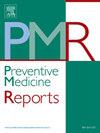高血压前期成人的睡眠模式与新发高血压和心血管疾病的风险:英国生物银行研究
IF 2.4
3区 医学
Q2 PUBLIC, ENVIRONMENTAL & OCCUPATIONAL HEALTH
引用次数: 0
摘要
目的探讨高血压前期人群综合睡眠模式与新发高血压(HTN)及心血管疾病(CVD)发生率的关系。该分析纳入了来自UK Biobank(2006-2010)的118,523名基线参与者,随访至2021年12月31日。睡眠模式包括时间类型、睡眠持续时间、失眠、打鼾和白天过度嗜睡。Cox比例风险回归模型用于估计风险比(hr)和95%置信区间(ci)。在12.5年的中位随访期间,10276名参与者(8.7%)发生HTN, 7665名参与者(6.5%)发生CVD事件。坚持健康睡眠模式的参与者患HTN的风险降低了27% (HR = 0.73;95% CI: 0.69-0.77),心血管疾病风险降低23% (HR = 0.77;95% CI: 0.72-0.82),与不健康睡眠模式的人相比。当作为一个连续变量进行分析时,较高的健康睡眠得分与疾病风险的逐步降低有关。结论健康的睡眠模式与高血压前期人群新发HTN和CVD风险降低显著相关,强调评估和优化睡眠健康作为高血压前期人群CVD临床一级预防策略的一部分的重要性。本文章由计算机程序翻译,如有差异,请以英文原文为准。
Sleep patterns and risk of new-onset hypertension and cardiovascular disease in prehypertensive adults: The UK Biobank Study
Objective
This study aimed to investigate the relationship between comprehensive sleep patterns and the incidence of new-onset hypertension (HTN) and cardiovascular disease (CVD) in individuals with prehypertension.
Methods
This analysis included 118,523 baseline participants from the UK Biobank (2006–2010) with follow-up through 31 December 2021. A sleep pattern included chronotype, sleep duration, insomnia, snoring, and excessive daytime sleepiness. Cox proportional hazards regression models were used to estimate hazard ratios (HRs) and 95 % confidence intervals (CIs).
Results
Over a median follow-up period of 12.5 years, 10,276 participants (8.7 %) developed HTN, and 7665 participants (6.5 %) experienced CVD events. Participants adhering to healthy sleep patterns had a 27 % lower risk of developing HTN (HR = 0.73; 95 % CI: 0.69–0.77) and a 23 % lower risk of CVD (HR = 0.77; 95 % CI: 0.72–0.82) compared with those with unhealthy sleep patterns. When analyzed as a continuous variable, higher healthy sleep scores were associated with a progressive reduction in disease risks.
Conclusions
Healthy sleep patterns are significantly associated with reduced risk the risk of new-onset HTN and CVD in people with prehypertension, emphasizing the importance of assessing and optimizing sleep health as part of clinical primary prevention strategies for CVD in prehypertensive populations.
求助全文
通过发布文献求助,成功后即可免费获取论文全文。
去求助
来源期刊

Preventive Medicine Reports
Medicine-Public Health, Environmental and Occupational Health
CiteScore
3.90
自引率
0.00%
发文量
353
 求助内容:
求助内容: 应助结果提醒方式:
应助结果提醒方式:


